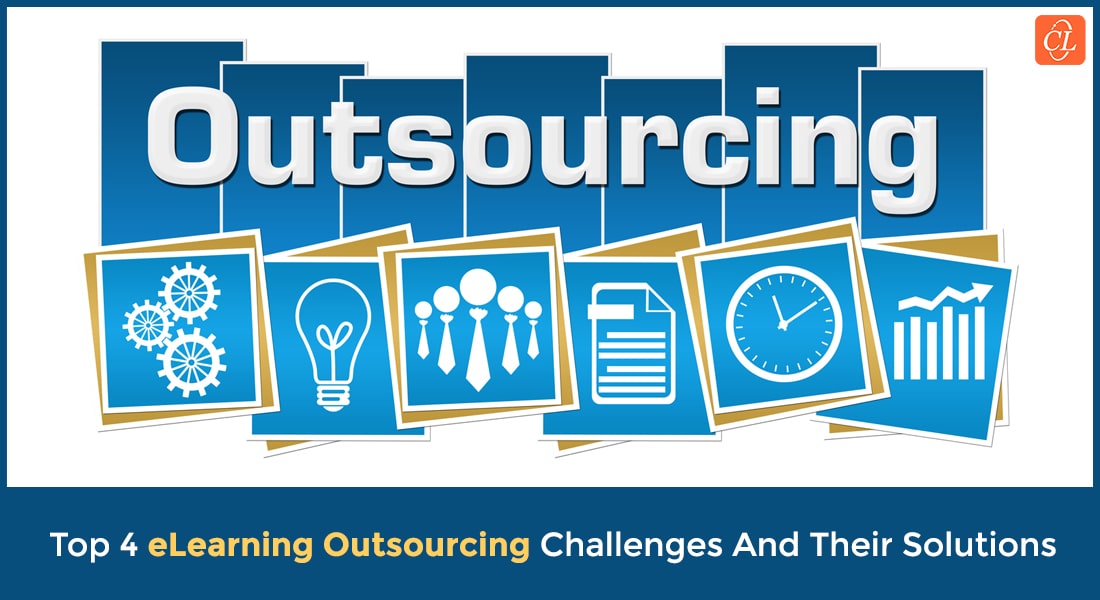4 Most Troublesome eLearning Outsourcing Challenges and How to Overcome Them

Outsourcing has been a popular trend for the past few years. Almost every company or business would prefer to outsource any sort of work that is needed for their business but doesn’t categorize well with their expertise. eLearning outsourcing is no different, as it might be highly unlikely for a company to develop a full-fletched training course on its own as per the latest trends. Any specific aspect can be outsourced separately or the whole development process can be outsourced altogether, depending totally on a company’s requirements and expertise.
Has eLearning Outsourcing Been a Hard Practice for You?
You must be familiar with one of these challenges:
- Project Management Control
- Final Product Expectations
- Budget Blowout
- Technical Issues and Timely Updates
Read on to know the ways to overcome these challenges
Even if outsourcing makes things sorted and somehow easier for the company to focus on things they can implement and execute themselves, there are quite a few challenges they would have to face. Let’s discuss a few major issues an eLearning development company has to face when they outsource their work and how to solve such issues in detail.
4 eLearning Outsourcing Challenges & Their Solutions
1. Project Management
When any eLearning project is outsourced, a handful of management responsibilities are split among the 2 parties. Sometimes, when a whole project is outsourced, the provider takes over most of the project management part from the owner. This can cause the owner to lose track of changes and development processes their project goes through. Mismanagement of internal tasks can cause severe issues to project development as the process includes multiple tasks at certain milestones.
Solutions:
- Review Meetings – Communication between the vendor and owner is the key factor for the development of a successful eLearning project or course. Regular review meetings should be held to maintain the flow of development as well as make the necessary changes. These meetings mark the various milestones of the development process. Any changes during the process can be thoroughly discussed in these meetings.
- Internal Project Manager – When you outsource a project, you should assign an internal project manager who takes care of multiple internal tasks. Some of the important tasks are getting feedback from subject experts, product testing at different stages, milestone approvals, etc. Apart from these tasks, an internal project manager is the only source of establishing contact between the owner and vendor. The allocation of an internal project manager streamlines the communication and helps in establishing an agile project management process.
Refer to this free eBook to gain insights on handling eLearning projects effectively.
2. Final Product Expectations
This is one of the most common issues faced when you outsource a project. When you outsource an eLearning project and list your requirements, there is a high chance you will not receive the exact product you asked for. The product may fall apart in terms of your cultural values or the learning objectives associated with your project.
Solutions:
- Detailed Project Brief – The project brief should give a detailed idea to the provider about your company and educate them properly regarding the project’s requirements. An ideal project brief would include necessary things like an introduction of your company, the purpose or goal of creating the eLearning project, preferred delivery method, target audience, technical details, schedule of regular meetings, and contact details of the company for further clarifications.
- Monitored Progress – Hosting review sessions can help the company to monitor the progression of their eLearning course. Early stage reviews are eventually better than late post-development feedback. If the changes are done early in the project or in the storyboard itself, the final product is more likely to meet the expectations of the company as all the confusion would already be resolved in the early development stage.
3. Budget Blowout
Outsourcing eLearning projects are not that pocket friendly, to begin with. They do save you money and resources but the budget scaling depends on the type of project you outsource. If the provider is not upfront with the quoted prices and includes hidden charges for side tasks, it might cause a budget blowout for the organization.
Solutions:
- Terms and Conditions Review – Carefully review the terms and conditions specified by the provider. These terms and conditions should include the budget breakdown for the processes and tools that assist the eLearning project development. During your regular review meetings, you can confirm which process was mentioned in the process and how it differs from the current build.
- Additional Expense Confirmations – It is advised to ask for confirmations and revisions whenever an extra expense is involved. Ideally, it’s a provider’s job to let you know if additional extra expenses are required but sometimes they don’t, so you have to take care and request multiple revisions of budget allotment to ensure a smooth flow of development and no surprising major expense shakes up your budget.
4. Technical Issues and Timely Updates
The final product might be digital but multiple factors are involved in the deployment and functionality of an eLearning project. When the project is outsourced, the new development team might use different tools that might differ from the tools your company uses. The compatibility and the platform where a project can be accessed might vary as per the use cases of the provider. Even after the project is delivered, you might have to rely on the provider if the project needs a future update due to the differences in technical resources used for the development.
Solutions:
- Compatible Tools and Resources – Using compatible and universally used tools and resources will help both parties have a fluid development process. Involving the IT team and letting the IT teams from both sides discuss the relevant tools and finalize them will save you from unforeseen technical issues in the later or post-development process.
- Future Maintenance and Updates – The ability to update your eLearning course after a required period of time is crucial. You wouldn’t feel satisfied if you feel the need to update your course but due to the difference in development resources, you are not able to update it, and thus you heavily rely on the provider. It’s better to discuss a quarterly, half-yearly, or yearly maintenance plan in your project brief to have things sorted for the future.
To Wrap It Up!
Outsourcing is still a significant initiative that leads to the development of an eLearning project. It is cost-effective and combines multiple expertise across several departments in a single project which promises a great return on value. Making things clear from the start, from quotations to building professional relationships, if things are kept sorted, outsourcing can really help the company to create valuable eLearning projects.
Choosing the right vendor is another important task that needs a separate discussion. You can refer to this free eBook to gain detailed insights on outsourcing and how to select the right vendor.





